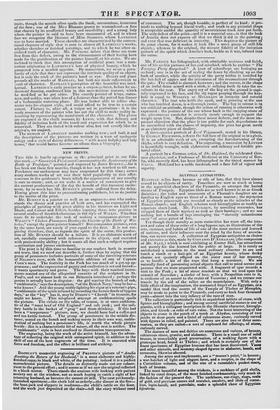NEW PRINTS.
Tins title is hardly appropriate to the principal print in our folio this week,—" Greenwich Pensioners Commemorating the Anniversary of the Battle of Trafielgar," painted arid engraved by JOHN BURNET,—for it has been out these few months, though it has not reached us till now. Perchance our enthusiasm may have evaporated by this time; certes many modern works of art owe their brief popularity to that effer- vescence in the quidnunc's brain which the appearance of any novelty is sure to create; and, as we make it a matter of conscience to give the current productions of the day the benefit of this transient excite- ment, by so much has Mr. BURNET'S picture suffered from the delay. Having given this hint to procrastinating publishers, let us do justice to the merits of the print. Mr. BURNET is a painter as well as an engraver—one who under- stands the theory and practice of both arts, and has expounded the principles of painting with great ability in his treatises on Light and Shade, and Colour and Effect, besides carrying them into practice in several studies of Scottish character, in the style of WiLate. Who then more fit to undertake the task of making a companion-picture to WILKIE'S " Chelsea Pensioners Reading the Gazette el the Battle of Wa- terloo," except the great painter himself? But companion pictures, even by the same hand, are rarely if ever equal to the first. It is not sur- prising therefore, that, as regards the spirit of the scene, this produc- tion of Mr. BURNET should be a failure. It is an elaborate work of art, carefully composed with reference to its object, and executed with praiseworthy ability ; but it wants all that such a subject requires —animation and joyous excitement. The print is by this time so familiar to our readers both in country and town, that we need not describe it, further than by saying that the group of pensioners includes portraits of some of the surviving veterans of NELSON'S crew, with the honourable addition of one of Captain COOK'S men. The festivity in the Park has too much of a got-up ap- pearance; and the expression of gayety and exultation is set and forced— it wants spontaneity and gusto. The boys with their nautical instru- ments remind one of the allegorical conceits of the sculptors in St. Paul's, and we almost look to see Britannia introduced; perhaps the genius is actually here in disguise : the girl waving the branch of oak, "emblematic," says the description, "of the British Navy," may be her— who knows ? And the young middy lighting his cigar at a veteran's pipe, "emblematic of the spirit infused by recording the heroic deeds of bygone days," as the "key" has it, may be DISDIN'S " Cherub " in trousers, for aught we know. This misplaced attempt at emblematizing spoils the picture. The sirloin on the table, of course, is at once emblema- tic of the "roast beef of Old England" and salt junk ; and the soli- tary bottle in the basket of "grog" and dram-drinking. If this had been a " temperance " picture, now, we should have had a coffee-pot and tea-kettle instead. The group of pensioners in the middle dis- tance, seated on the bench and making merry in their own way, male- matical of nothing but a pensioner's life, is worth the whole picture beside : this is a characteristic bit of nature, all the rest is artifice. The "emblematic" style is best confined to illumination transparencies. The engraving, being the work of the artist himself, has the advan- tage of reflecting the original with unimpaired spirit, in addition to the skill of one of the best engravers of the time. It is executed with force and freedom, and the effect is brilliant and striking.


























 Previous page
Previous page